Sub set: a new exhibition traces African modernist architecture

If architecture is, as Mies van der Rohe famously claimed, ‘the will of an epoch translated into space’, how was the break from colonial rule expressed in the built environment? With daring and optimism – at least in the sub-Saharan Africa of the mid-twentieth century, when newly independent African countries were confronting complex issues of sovereignty and national identity. An exhibition organised by the Vitra Design Museum, on view until the end of May at New York’s Center for Architecture, explores this little-known wave of ‘African Modernism’.
‘When the countries of sub-Saharan Africa became independent, the young nations used architecture as a tool for nation building,’ says Manuel Herz, curator of the exhibition and editor of the accompanying book African Modernis’, published by Park Books. ‘I wanted to focus on the countries that became independent in the years between the late 1950s and the early 60s, as I also wanted to focus on architecture of the 1960s and 70s.’ And so the government buildings, museums, schools, universities and conference centres featured in the show are in five budding nations: Ghana, Senegal, the Ivory Coast, Kenya and Zambia.

Kenyatta International Conference Centre, Nairobi, Kenya, designed by Karl Henrik Nostvik, 1967–1973.
Glass vitrines contain archival ballast – sketches, plans, newspaper clippings, commemorative stamps – but it is the contemporary photography at the heart of the exhibition that brings the modernist projects to life, contextualising their grand ambitions within messy, multi-layered realities. Reproduced at snapshot scale in wooden-framed, wall-mounted groupings, images by Iwan Baan and Alexia Webster show each of the approximately 80 featured buildings as ‘actors in the urban environment’, explains Herz. 'It doesn’t make the building a hero but shows how they curate urban space.’
Spanning five distinct countries and the work of mainly Western architects, the exhibition reveals both commonalities – the use of concrete, lifted volumes, a flowering of latticed screens – and specificities. ‘[The] programme was different,' says Herz, offering the example of Ghana’s dedication to educational institutions while the neighbouring Ivory Coast was focused on office buildings and public housing. And materiality often varied widely. ‘In Zambia, brick was used frequently, while this is almost unknown in Kenya, resulting in very different architectural expression, even though the climates of the countries’ capitals are quite similar.’
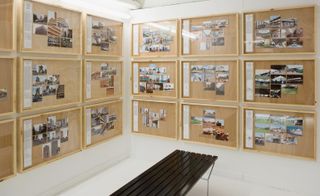
Installation view of the exhibition
There is much to see, from the beautiful optimism of Abidjan’s Hôtel Ivoire (conceived by Moshe Mayer as a glamorous icon of the ‘African Riviera’ he envisioned) and the remarkable Foire Internationale de Dakar (FIDAK, the International Trade Fair of Dakar) to the National Assembly of Zambia, where a taxidermy tiger and lion prowl the floor of parliament, and Nairobi’s Chai House, an elevated, UFO-shaped nightclub tiled like a disco ball.
‘When we think of Africa in terms of architecture, we usually only think of slums, slum-upgrading, emergency housing, or “humanitarian architecture” such as orphanages,’ says Herz. ‘This exhibition will hopefully shift the way we look at the African continent today, not as a region of poverty and misery, but as a continent full of amazing cultural and architectural production on the highest level.’

Exterior view of the exhibition, 'African Modernism', organised by the Vitra Design Museum, on view until 27 May at New York’s Center for Architecture

School of Engineering at KNUST (Kwame Nkrumah University of Science and Technology), Kumasi, Ghana, designed by James Cubitt, 1956.

University of Zambia (UNZA), Lusaka, Zambia, designed by Julian Elliott and Anthony Chitty, 1965–1968.
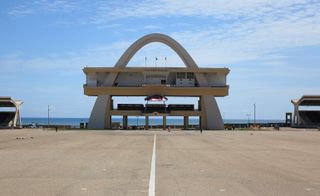
Independence Arch, Accra, Ghana, designed by the Public Works Departments, 1961.
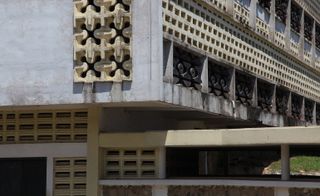
Mfantsipim School (Ausschnitt), Cape Coast, Ghana, designed by Fry, Drew and Partners, 1958.

Hotel Ivoire, Abidjan, Ivory Coast, designed by Heinz Fenchel and Thomas Leiterdorf, 1962–1970.

Kenyatta International Conference Centre, Nairobi, Kenya, designed by Karl Henrik Nostvik, 1967–1973.
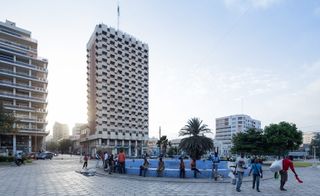
Hotel Independence, Dakar, Senegal, designed by Henri Chomette and Roland Depret, 1973–1978.

La Pyramide, Abidjan, Ivory Coast, designed by Rinaldo Olivieri, 1973.
INFORMATION
’African Modernism’ is on view until 27 May. For more information, visit the Center for Architecture website
ADDRESS
Center for Architecture
536 LaGuardia Pl
New York, NY 10012
Wallpaper* Newsletter
Receive our daily digest of inspiration, escapism and design stories from around the world direct to your inbox.
Stephanie Murg is a writer and editor based in New York who has contributed to Wallpaper* since 2011. She is the co-author of Pradasphere (Abrams Books), and her writing about art, architecture, and other forms of material culture has also appeared in publications such as Flash Art, ARTnews, Vogue Italia, Smithsonian, Metropolis, and The Architect’s Newspaper. A graduate of Harvard, Stephanie has lectured on the history of art and design at institutions including New York’s School of Visual Arts and the Institute of Contemporary Art in Boston.
-
 The best design-led cocktail shakers
The best design-led cocktail shakersIf you like your drinks shaken not stirred, these are the best cocktail shakers to take your mixology skills to the next level
By Rosie Conroy Published
-
 Tech Editor, Jonathan Bell, selects six new and notable Bluetooth speaker designs, big, small and illuminating
Tech Editor, Jonathan Bell, selects six new and notable Bluetooth speaker designs, big, small and illuminatingThese six wireless speakers signal new creative partnerships and innovative tech approaches in a variety of scales and styles
By Jonathan Bell Published
-
 As London’s V&A spotlights Mughal-era design, Santi Jewels tells of its enduring relevance
As London’s V&A spotlights Mughal-era design, Santi Jewels tells of its enduring relevance‘The Great Mughals: Art, Architecture and Opulence’ is about to open at London’s V&A. Here, Mughal jewellery expert and Santi Jewels founder Krishna Choudhary tells us of the influence the dynasty holds today
By Hannah Silver Published
-
 Tour this Bel Vista house by Albert Frey, restored to its former glory in Palm Springs
Tour this Bel Vista house by Albert Frey, restored to its former glory in Palm SpringsAn Albert Frey Bel Vista house has been restored and praised for its revival - just in time for the 2025 Palm Springs Modernism Week Preview
By Hadani Ditmars Published
-
 A new exhibition marks Chandigarh’s modernist legacy
A new exhibition marks Chandigarh’s modernist legacy‘Celebrating the Capitol’, an exhibition of photographic work by architect Noor Dasmesh Singh, opens just in time for the famed modernist Indian city’s anniversary
By Ellie Stathaki Published
-
 Join our tour of London Zoo, its modernist architecture and more
Join our tour of London Zoo, its modernist architecture and moreLondon Zoo is a well-established magnet for younger visitors, but there's plenty for the architecture enthusiast to admire too; our tour explores its modernist treasures for guests of all ages
By Ellie Stathaki Published
-
 La Grande Motte: touring the 20th-century modernist dream of a French paradise resort
La Grande Motte: touring the 20th-century modernist dream of a French paradise resortLa Grande Motte and its utopian modernist dreams, as seen through the lens of photographers Laurent Kronental and Charly Broyez, who spectacularly captured the 20th-century resort community in the south of France
By Ellie Stathaki Published
-
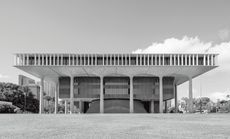 'Mid-Century Modern Masterpieces' captured in new monograph like no book before
'Mid-Century Modern Masterpieces' captured in new monograph like no book before'The Atlas of Mid-Century Modern Masterpieces' chronicles hundreds of iconic structures from this golden age of architectural expression
By Jonathan Bell Published
-
 Discover Tempe à Pailla, a lesser-known Eileen Gray gem nestled in the French Riviera
Discover Tempe à Pailla, a lesser-known Eileen Gray gem nestled in the French RivieraTempe à Pailla is a modernist villa in the French Riviera brimming with history, originally designed by architect Eileen Gray and extended by late British painter Graham Sutherland
By Tianna Williams Published
-
 'American Modern' surveys the 'total community' modernist project that was Columbus, Indiana
'American Modern' surveys the 'total community' modernist project that was Columbus, Indiana'American Modern', a new publication zooming in on the lesser-known architectural gems of Columbus, Indiana, and their impact, is out this month
By Adrian Madlener Published
-
 'Tropicality' explored in Indonesian architect Andra Matin’s first monograph
'Tropicality' explored in Indonesian architect Andra Matin’s first monograph'Tropicality' is a key theme in a new book on Indonesian architect Andra Matin, whose work blends landscape, architecture and living
By Harriet Thorpe Published